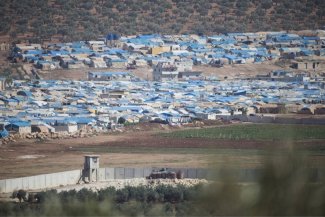Troublesome guests. Turkey’s plans regarding the Syrian refugee issue

The presence of Syrian refugees is putting increasing strain on Turkey. Since the migration agreement was signed with the EU in March 2016, the number of refugees in Turkey has risen from more than 2.7 million to more than 3.6 million. The growing anti-Syrian sentiment among the public poses a threat to the ruling Justice and Development Party (AKP). Faced with the prospect of a new wave of refugees from the Syrian province of Idlib, Ankara is determined and prepared to take radical measures to reduce the danger the migration issue presents for the government.
The most important measure taken is the preparations being made to set up a buffer zone in northern Syria. This would serve as a location for returning at least a portion of the Syrians from Turkey, as well as a destination for potential new refugees from Idlib. This will be a difficult undertaking, even in view of the White House’s announcement of withdrawal of US troops from northern Syria. This makes it even more important for Ankara to seek political and financial support in the EU for its actions. If the West does not get on board for the buffer zone project or accept requests to revisit current cooperation with regard to migration, Turkey might resort to lapses in control of illegal people’s movement, or even stimulate it, which could open a new chapter in the migration crisis in Europe.
Migration crisis – the key is in Ankara
Turkey played a central role in the migration crisis, as it had influence over both the manner in which it unfolded, and the manner in which it was dealt with, and the authorities in Ankara were aware of this. The Syrian refugee issue has now taken on a different meaning in Turkish politics, however. While Turkey may have deftly handled the issue to its advantage in foreign policy in 2015–2016, it has now taken on extraordinary importance in view of the domestic situation, and consequently affects the position of the ruling party.
Since the civil war in Syria began, Turkey has received refugees from the country and organised aid for them within its own territory[1]. At the height of the crisis, in mid-2015, the unchecked flow of refugees into the EU gave Ankara leverage with Brussels to gain certain political benefits for Turkey in its relations with the EU. Under the deal reached in March 2016 between Ankara and Brussels, EUR 6 billion in aid was to be provided, 3 billion in 2016–2017, and the same amount in 2018–2019. A mechanism was also put in place for the EU to begin to send a number of illegal migrants from the EU to Turkey equal to the number of Syrians granted asylum and sent from Turkey to the EU. This was intended to stop people attempting to get from Turkey to the EU by themselves, and thus curb human trafficking via the Aegean Sea. In addition, Turkey made a commitment to tighten up border service and coastguard control over its own coastline. In return, in addition to the agreed financial aid, one of the undertakings made by Brussels was to open one of the chapters in accession talks for Turkey, and to speed up the easing of visa requirements for Turkish citizens travelling in the EU[2].
Turkey implemented the adopted solutions, and, when these were combined with measures taken by other countries, such as the stopping of large-scale flow of immigrants through the Balkans, the effects were almost instantaneous. In June 2016, the number of refugees entering the EU fell by more than 95%[3]. The progress achieved due to the agreement with the EU, and the manageable scale of human movement, which continues today, demonstrate that in recent years Turkey has had both the opportunity and the means necessary to make a considerable contribution to overcoming the crisis.
Turkey continued these measures despite no progress being made in the accession talks[4] or regarding the prestigious issue for Turkey of relaxation of visa requirements, and also despite miscommunication regarding the timeframe and procedure in which the agreed financial aid would be disbursed[5]. This was accompanied by occasional increases in tension and rhetorical disputes – in particular accusations made by President Recep Tayyip Erdoğan against the West of hypocrisy and having no regard for harms done to Muslim communities. All of this severely undermined the atmosphere in the bilateral relations. Nevertheless, from Turkey’s standpoint, the mere easing of the financial burden due to cooperating with the EU yielded benefits. This can be seen by the tempering of the rhetoric relating to the expected rapid progress in realisation of the EU’s commitments towards Turkey as discussed above.
More than three and a half years after the agreement with the EU was signed, Turkey’s refugee policy has in fact transformed. Drawing attention to the major humanitarian contribution made by Ankara towards helping Turkey’s Muslim neighbours fleeing a country devasted by war now no longer reinforces the government’s position, in fact the reverse is true – the presence of millions of refugees is placing more and more strain on the government.
Casting off the refugee yoke
The presence of 3.6 million Syrians in Turkey is causing more and more domestic problems for the government. The most serious problem is, anti-Syrian resentments in society which also has repercussions for the popular view of the government’s refugee policy. A large portion of the Syrian community in Turkey has become ghettoised over the last seven years, often doing the worst paid jobs, and kept separate from the Turkish community[6]. Although there are no collective empirical studies that show an increase in hostility towards refugees, there have been a series of examples indicating that this worrying trend exists. For example, the non-governmental organisation Change.org, which monitors xenophobic moods, says that since the war in Syria began, 73 spontaneous campaigns inciting hatred towards Syrians have been organised in Turkey, and were well received on a large scale by users of social media[7].
There is a sharp contrast between this increase in hostility and the overall rhetoric used by the government and pro-government media up to now, showing Turkey’s exemplary fulfilment of the humanitarian obligation towards fellow Muslims[8]. This argument, which is an element of the message that Turkey has the ‘ moral advantage’ in relation to the West, has also improved the country’s image in the Muslim world. At the moment, however, the refugee issue is beginning to cause the government more and more problems. The most important sign that the policy employed to date could backfire on the government was the repeated holding of the election for mayor of Istanbul in June 2019. The defeat of AKP candidate Binali Yıldırım was even more painful for the party due to its own electorate, often conservative and religious voters, switching to the opposition. The main reason often given for the support enjoyed by the opposition candidate is precisely a failure to solve the Syrian problem[9]. Currently, approximately 1 million Syrians live in Istanbul alone, of which half are officially registered.
The refugee question has also led to tension inside the government. For a long time, the Nationalist Movement Party (MHP), which is in an alliance with the ruling AKP, and has formed a parliamentary majority with that party, has been moderate in its declarations. For a number of weeks, the leader of the nationalists, Devlet Bahçeli, has been advocating sending Syrians back from Turkey as soon as possible, in response to the mood among his electorate[10]. This means that finding at least a partial solution to the refugee problem could be an issue on which the future rule of Erdoğan and of his party depends.
Safe zone in northern Syria
Given the growing tension at home, and the danger that maintaining the status quo as regards refugees presents for the government, the authorities in Ankara have shown stiff determination to find a solution not only to the migration problem, but also to a range of other problems related to the adverse consequences the war in Syria has had for Turkey.
Since the summer of 2019, Ankara has been taking an increasingly firm stand in its insistence that a security zone needs to be created in northern Syria. Referred to by Turkish officials as the ‘safe zone’ or ‘peace corridor’, this zone is to be formed along the entire border and stretch 30 km inside Syria. It is presented as a place for relocation of Syrian refugees. From a political and military point of view, the zone is in fact designed to be a buffer between the southern border of Turkey and the Kurdish parastate (the so-called Rojava), governed by the Democratic Union Party (PYD). Ankara sees this formation as a Syrian faction of the Kurdistan Workers’ Party (PKK), with which Turkey has been at war for more than thirty years. By forcibly pursuing plans for the buffer zone, Ankara wishes to achieve a number of political goals at the same time – remove refugees from the country, guarantee their safety, and create a military border zone occupied by the loyal Arab population. The current refugees are Syrian citizens of various origin, opposed to and persecuted by the Assad regime. The majority are Sunni Arabs (this group also includes Palestinians and Syrian Turkmen and Kurds) who since the domestic conflict began have seen Turkey under AKP rule as cause for hope or treated it as a model for possible system transformation in Syria.
Implementation of the plan for the security zone has de facto been in progress for several years in northern Syria, which is under direct Turkish control[11]. Ankara intends to expand the zone to cover an area of 480 km east of the Euphrates, under the control of the Syrian Kurds. This is a plan that is extremely hard for Turkey to achieve on its own. Even though the US has given consent for Turkish troops to enter Syria, they have opposition from Kurdish forces in this area to contend with (and this includes in two crucial urban centres of the parastate – Kobane and Kamışlı. The range of actions and theatre of activity that the US has agreed to for Turkey under the agreement between the leaders of the two countries signed on 6 October is not clear either.
For Turkey, the proposed width of the zone is dictated by the range of its own artillery. This distance is intended to both protect the refugees placed there, and protect Turkish territory itself against fire from Syria. The Turkish defence minister said recently that military bases would have to be built in the buffer zone, similar to Turkish reinforced posts established in the Kurdistan Region in northern Iraq.
Turkey intends to resettle approximately 1–3 million Syrian refugees in the buffer zone, and build the appropriate infrastructure – according to Turkish state television, the government is planning to spend as much as USD 27 billion on construction of new settlements[12]. Extensive interference in the ethnic make-up of the border zone would also be an element of the overall plan[13].
Another factor leading Ankara to create the zone is the situation in the Syrian region of Idlib. Under the Astana agreements with Russia and Iran, Turkey is formally in control of this area as a ‘de-escalation zone’. This region is the last stronghold of the Syrian armed opposition, for which Turkey has acted as a patron since the war began. In practice, however, the activities of the Turkish forces in this area are paralysed, and the regime forces are making progress in regaining the territory. This area is inhabited by approximately 3.5 million people. If Bashar al-Assad’s army is successful, most of these people will be potential new refugees. For this reason, in recent weeks, Erdoğan has presented plans for the security zone also as a potential place for evacuation of the civilian population from Idlib.
The most serious obstacle to achieving Turkey’s policy objectives is the lack of correlation between Turkey’s plans and the US’ plans, and their incompatibility. For Turkey, the Kurdish parastate in north-eastern Syria (like its headquarters in northern Iraq) is the existential foe, while for the US it is an important ally. Ignoring Turkey’s standpoint, and the struggle against the PKK, which Turkey considers its raison d’état, Washington is still looking for a modus vivendi between Turkey and the Syrian Kurds, and is also looking for a safe place for them in the political landscape in post-war Syria.
Prospects: new pressure on the EU
In recent weeks, the refugee issue in Turkey has become the greatest political burden since the war in Syria broke out. The gravity of the situation is illustrated by the government’s actions. The government plans to take an all-embracing approach to the problem, seeing the security zone as a solution to the threats caused by the continuing conflict beyond the country’s southern border. Creating the buffer zone could be very difficult, and will not necessarily lead to favourable results. Turkey will have to overcome opposition from Kurdish forces, and, even if it is successful in doing so, constructing the zone could mean a series of lengthy, expensive, and controversial logistical projects to resettle refugees.
Turkey’s actions in northern Syria will have a high political and financial cost, and for this reason Ankara will also expect support from the EU. This is how expressis verbis suggestions, and a visible increase in illegal migration recorded on the Aegean Sea since the end of July[14] should be interpreted. President Erdoğan has already threatened to stop honouring the 2016 agreement, saying that Turkey does not have the resources to continue to care for refugees without the proper external support. At the same time, Greece has recorded the largest collective inflow of people for three years, and the Greek foreign ministry, summoning the Turkish ambassador, suggested openly that desisting from action on the part of Turkey made sense[15]. It is highly likely therefore that in the coming months Turkey will make demands and threats and use other forms of pressure in relations with the EU when seeking support for creation of the buffer zone.
Map. Buffer zone in Syria proposed by Turkey

[1] There are currently just over 3.6 million registered Syrian refugees in Turkey (of whom less than 10% are in camps). The authorities in Ankara say that the aid they have been given since 2011 has cost more than USD 35 billion, but this figure is hard to verify. S. Sazak, ‘Turkey Can’t Host Syrian Refugees Forever’, Foreign Policy, 27.08.2019.
[3] Implementing the EU-Turkey Statement – Questions and Answers, Brussels, 15.06.2016.
[4] In this case, there was a gradual ebbing in motivation on both sides, and the accession process has de facto been suspended without any prospect of this changing.
[5] Almost since the agreement took effect, Ankara has been expressing its discontent due to expecting funds to be deposited into Turkish bank accounts. However, Brussels releases the money to agencies carrying out specific projects in Turkey, such as activities of schools, and outlets providing medical, humanitarian or material aid. According to official EC figures, out of the agreed EUR 6 billion in aid, by 30 September 2019 5.8 billion had been raised, 4.2 billion had been approved, and 2.57 billion spent. See EU Facility for Refugees in Turkey. List of projects committed/decided, contracted, disbursed.
[6] F. Çelik, ‘İzlenim: Türkiye’de Suriyeli mülteci olmak – Nefret söyleminin gölgesinde gettoya sıkışmak‘, Medyascope, 15.07.2019.
[7] Suriyelilere karşı nefret kampanyası, „Gazete Duvar”, 22.07.2019.
[8] This rhetoric was particularly forceful when prime minister Ahmeta Davutoğlu was in power (2014–2016) and reflected a particular kind of neo-ottoman paternalism towards the Arab population.
[9] ‘Seçim sonuçları: İstanbul Fatih'te AKP seçmeni İmamoğlu'nun zaferi için ne diyor?’, BBC Türkçe, 24.06.2019.
[10] F.S. Yüksek, ‘Türkiye’de siyaseti kuşatan sorun: Suriyeli göçmenler’, Euronews, 13.09.2019.
[11] In the northern part of the de-escalation zone in Idlib and in Syrian border areas under Turkish control in operations Euphrates Shield and Olive Branch.
[12] T. Gumrukcu, ‘Turkey not satisfied with talks with U.S. on Syria «safe zone»’, Reuters, 27.09.2019.
[13] According to current estimates, the 30-kilometre border zone, which stretches from the Euphrates to the Tigris, which Turkey intends to take over, is inhabited by approximately 850 000 people – 650 000 Kurds (76%), 180 000 Sunni Arabs (21%), 10 000 Turkmen (1%) and 10 000 Christians (1%). Only one of the regions in the future zone (Tall Abyad) has an Arab majority. See M. Eisenstadt, S. Cagaptay, A Turkish ‘Safe Zone’ in Syria: Prospects and Policy Implications, Policywatch 3088, 1.03.2019. For more information about migration and ethnic, linguistic, and religious cleansing and divisions in Syria in recent years, see F. Balanche, Sectarianism in Syria’s Civil War. A Geopolitical Study, The Washington Institute for Near East, 2018.
[14] In September, an increase of a few percent was recorded in the number of refugees coming to the Greek islands. The overall trend is more important however. Greece is the EU country that took in the most migrants this year (in total 45 500, Italy 7 800 and Spain 22 900) and is continually dealing with the greatest pressure in this respect. Possible stimulation of migration on the Turkey-Greece route means significant pressure on the entire EU. Data for: Most common nationalities of Mediterranean sea and land arrivals from January 2019, The Refugees Operational Portal.
[15] Turkey has denied these allegations. See K. Tagaris, ‘Greece sees first mass arrival of migrant boats in three years’, Reuters, 30.08.2019.




